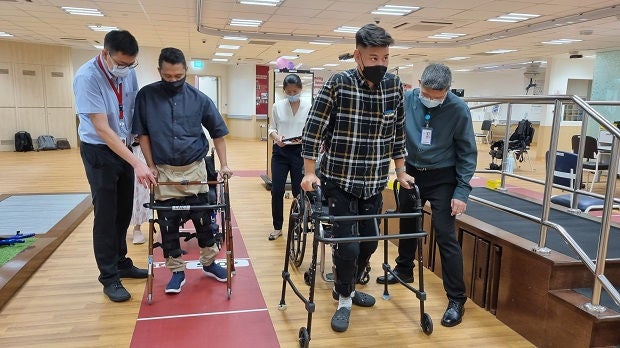
A multidisciplinary team comprising members from NNI, TTSH and A*STAR has found a way to restore movement in patients paralysed from the chest down.
When he was flung off his horse during training, competitive jockey Mr Sam Subian fractured his spine and was told he would never stand or walk again. He was devastated. That was six years ago. Now, thanks to an implant and a whole lot of hard work and determination, Mr Sam is starting to walk again.
The implant and intensive rehabilitation programme he underwent were part of RESTORES (restoration of rehabilitative function with epidural spinal stimulation), a clinical trial conducted by the National Neuroscience Institute (NNI), Tan Tock Seng Hospital (TTSH), and the Agency for Science, Technology and Research (A*STAR). It is the first of its kind in the region.
“It took me a while to accept my situation. Just as I was coming out of a low point, I was told about the trial. I didn’t hesitate at all to sign up,” said Mr Sam, who is the first of three participants in the trial. All three suffered complete spinal cord injuries.
When the spinal cord is damaged, transmission of electrical signals to and from the brain is disrupted. “Depending on which part of the spinal cord is severed, patients will not be able to move their arms and legs, or have any sensation below the level of the injury,” said Dr Wan Kai Rui, Consultant, Department of Neurosurgery, NNI.
Together, NNI and TTSH treat about 100 new cases of spinal cord injury a year, and about 95 per cent of them with severe injuries show no neurological improvement five years after their injury. But having an implant — an electrode placed on the surface of the spinal cord near the damaged area — can help patients overcome this.
“The spinal cord stimulator helps bridge
the damaged part of the spinal cord and
boost signals from the brain to the muscles
by tapping residual pathways that are
still viable,” said Dr Wan, who is also the
principal investigator of the trial.
However, the implant alone is not enough; rehabilitation is also vital.
Prior to the implant operation, Mr Sam underwent one month of twice-weekly rehabilitation to strengthen his limbs and core. After recuperating for a month postsurgery, he was back again for rehabilitation five times a week for seven months.
In the past, patients with spinal cord injuries also underwent rehabilitation, but it was mostly to help them cope with their disability. “What we are doing now is restorative rehabilitation, where we are actually working on restoring function,” said Dr Valerie Ng, Consultant, Department of Rehabilitation Medicine, TTSH, and co-principal investigator of the study.
Various techniques of rehabilitation were used in this trial. These included motor imagery, where patients imagine a movement although they cannot actually perform the physical movement; truncal rehabilitation and an advanced robotic exoskeleton, where patients use a suit to hold them upright and ‘walk’ the legs so that their dormant muscles can be reactivated. By recording and analysing signals from the muscles, researchers noted a significant improvement in nerve function and muscle activity in these patients.
The second participant, financial adviser Mr Asyraf Ghazali, was in a road accident five years ago. Just like Mr Sam, he was paralysed from the chest down. “I was not ready to accept it and was continuously looking for treatments to help me walk again,” he said.
Although Mr Asyraf found one in Thailand, they were not accepting patients with complete impairment of the spinal cord. “So the moment I was offered the opportunity to be on the clinical trial, I jumped on it,” he stated. Mr Asyraf received his implant in Standing and walking on their own two feet again March 2023, a month after Mr Sam. The third participant, a woman, had an electrode implanted in January 2024.
Both men were up and taking their first steps and walking within a month of starting rehabilitation. “But because they have not walked for so long, we had to work on strengthening their muscles during the remaining five to six months so that they can support their own weight and be off the safety harness,” added Dr Wan.
While they are able to move, they cannot feel themselves moving and were therefore initially sceptical. “I just put the movements down to spasms. But as the rehab progressed, the greatest thing was to see movements I didn’t think were possible,” said Mr Asyraf.
With the success stories so far, the multidisciplinary team intends to move into the next phase of the trial with about 15 patients. “We will be looking at those with paralysis from the neck down. We hope that the electrode stimulation can also help with functional improvement of their arms,” shared Dr Wan.
For Mr Sam, his experience has shown him that what appears to be an irreparable situation can still turn around. “Hopefully, this will inspire others to not lose hope.”
Get the latest updates about Singapore Health in your mailbox! Click here to subscribe.













 Get it on Google Play
Get it on Google Play